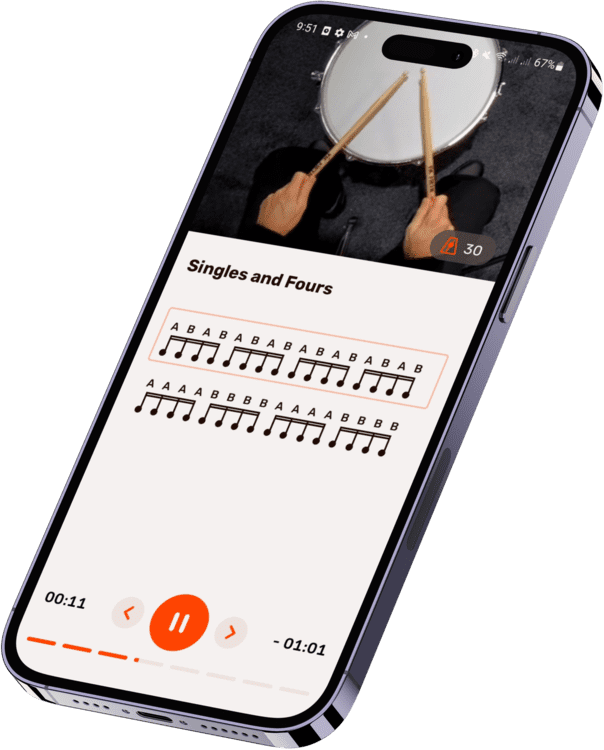Embarking on the quest for rhythmic mastery, drum rudiments emerge as the quintessential elements that every drummer must intimately understand and practice. These patterns, often considered the heartbeat of drumming, pave the way for drummers to achieve both technical finesse and a deeply expressive musicianship. This exploration delves into the core drum rudiments, expanding upon insights in alignment with our vibrant discussions found within Drumap resources. By diving deep into these rudiments, drummers unlock the door to boundless creativity and skill, marking significant milestones on their musical voyage.
Dream big, drum bigger! With Drum Coach, invest just 5 minutes daily for fun and effective practice that swiftly enhances your drumming. Begin your journey to greatness today!
1. Essential Drum Rudiments for Maintaining Tempo and Rhythm
At the core of drumming lies an ensemble of essential rudiments, each serving as a pivotal stepping stone for drummers on their journey to rhythmic mastery. These rudiments, often likened to the alphabet for drummers, empower them to articulate complex rhythms and musical narratives with precision and fluency. Below, we expand upon our narrative with a listing of principal rudiments, each a key player in the vast world of drumming dynamics:
- Single Stroke Roll – The most fundamental rudiment, consisting of consecutive, alternating strokes (R L R L). It lays the groundwork for developing speed, endurance, and coordination.
- Double Stroke Roll – This rudiment involves repeating pairs of strokes on each hand (R R L L), crucial for building control and fluidity in playing.
- Paradiddles – A hybrid pattern that combines single and double strokes (R L R R, L R L L), paradiddles enhance versatility, allowing drummers to navigate across the drum set with ease.
- Flams – A rudiment that pairs a grace note with a primary stroke (flaR, flaL), adding texture and depth to drumming patterns.
- Drag – Similar to flams but with two grace notes leading into the primary stroke, drags contribute to the dynamic richness of drum fills and solos.
- Five Stroke Roll – This pattern (R R L L R, L L R R L) further complicates the double stroke by adding a single stroke at the end, useful for creating smooth and complex drum fills.
- Seven Stroke Roll – An extension of the stroke roll family, adding more strokes (R R L L R R L, L L R R L L R) to create longer and more intricate patterns.
- Triple Stroke Roll – Involving three consecutive strokes on each hand (R R R, L L L), this rudiment helps in developing stamina and control for playing fast, rolling patterns.

Rudiments, a drummer’s alphabet, enable precise and complex rhythm articulation.
Dreaming of becoming a drumming pro? Dive into Drum Coach’s world, where every beginner finds their groove! With the Drumming Essentials course you get:
🥁 Fun 5-minute daily routines.
🎵 Progress at your pace, perfect for starters.
💡 Engaging lessons that make learning easy and effective.
By diligently practicing these foundational rudiments, drummers not only refine their technical skills but also expand their creative repertoire. Each rudiment offers a unique set of challenges and opportunities for musical expression, serving as building blocks for complex rhythms and fills. Integrating these rudiments into daily practice sessions, drummers can explore new textures and rhythms, pushing the boundaries of their musicality and performance.
2. Step-by-Step Guide to Practicing Rudiments
Mastering the art of drum rudiments requires a structured approach and the right tools for practice. A daily routine, combined with the effective use of a practice pad, can significantly enhance a drummer’s progress. Here’s an expanded guide on forming a daily routine and the crucial role of a practice pad in rudiment mastery.
A well-structured daily routine ensures consistent improvement and helps drummers stay focused on their goals. Here’s a recommended daily practice plan:
- Warm-Up (10-15 minutes): Begin with simple stretches for your hands, wrists, and shoulders to prevent injury. Use the practice pad for basic single strokes (R L R L) and double strokes (R R L L) at a comfortable tempo to warm up.
- Focused Rudiment Practice (20-30 minutes): Start with the foundational rudiments like Single Stroke Rolls, Double Stroke Rolls, Paradiddles, and Flams. Work each rudiment slowly, focusing on clarity and evenness. Gradually increase the tempo as you become more comfortable.
- Rudiment Combinations (15-20 minutes): Combine different rudiments to create complex patterns. This exercise enhances creativity and prepares you for applying rudiments in musical settings.
- Metronome Practice (15-20 minutes): Practice the rudiments with a metronome. Start at a slow tempo and gradually increase the speed while maintaining accuracy. This step is vital for developing timing and speed.
- Cool Down (10 minutes): End your practice session with slow, deliberate strokes on the practice pad to relax your muscles. Reflect on your progress and areas that need improvement.
A well-structured daily routine with drum rudiments ensures consistent improvement and helps drummers stay focused on their goals

Want to unlock your full drumming potential? Drum Coach is your gateway to excellence with our 5min practice. Get started today!
The practice pad is an invaluable tool for drummers, offering a convenient and effective way to hone rudiment skills. Its benefits include:
- Portability: Practice pads are lightweight and portable, allowing drummers to practice anywhere, anytime.
- Volume Control: They enable quiet practice, making them ideal for environments where noise could be an issue.
- Focused Learning: Without the distractions of a full drum set, drummers can concentrate on stick control, wrist movement, and stroke accuracy.
- Surface Response: The pad’s rebound mimics that of a snare drum, providing a realistic feel that translates well to the drum set.
Incorporating a practice pad into your daily routine not only sharpens your rudimental skills but also builds the muscle memory and control needed for dynamic drum set playing. Whether at home, on the road, or in a quiet space, the practice pad is a drummer’s faithful companion on their journey to mastery. Remember, the key to progress is consistency, patience, and mindful practice. Embrace the practice pad, and let it guide you through the intricate world of drum rudiments, paving the way to rhythmic excellence and beyond.
Dreaming of becoming a drumming pro? Dive into Drum Coach’s world, where every beginner finds their groove! With the Drumming Essentials course you get:
🥁 Fun 5-minute daily routines.
🎵 Progress at your pace, perfect for starters.
💡 Engaging lessons that make learning easy and effective.
3. Using Rudiments to Build Complex Drum Patterns
Upon solidifying your grasp on basic rudiments, the adventure continues as you interlace them into intricate drum patterns. This stage is where your creative spirit flourishes. Merging various rudiments allows drummers to concoct distinct rhythms and fills, injecting depth and texture into their musical endeavors. This creative synthesis is not solely about showcasing technical prowess; it involves a profound comprehension of each rudiment’s musical potential, empowering drummers to traverse new musical landscapes with confidence.
4. Techniques for Speeding Up Your Rudiment Practice
A common hurdle for many drummers is enhancing their speed without compromising accuracy. To vault over this, begin your practice at a deliberate, slow pace, focusing on precision. As comfort and confidence build, gradually elevate the tempo. Interval training—alternating between rapid execution and slower, deliberate play—proves immensely beneficial. Moreover, documenting and reviewing your practice sessions offers critical insights, illuminating areas ripe for improvement.
Drum Coach offers drumming exercises tailored for at all levels.
With Drum Coach you get:
- Drums lessons crafted by Mariano Steimberg, professional drummer, and professor at Berklee College of Music.
- Unlock over 500 drum exercises and rudiments

5. Apps and Tools for Learning Rudiments on the Go
In our digitally connected era, a plethora of apps and tools stand ready to support drummers in their rudimental education. These digital allies offer interactive exercises, immediate feedback, and customized learning trajectories, complementing traditional practice regimens. Drum Coach, for instance, shines brightly with its extensive rudiment library, progress tracking features, and engaging exercises tailored for drummers, ensuring even those with the most hectic of schedules can find time to practice.
In wrapping up, the journey toward drum rudiment mastery lays the groundwork for becoming a skilled and expressive drummer. Through unwavering practice, practical application, and harnessing modern educational tools, drummers can elevate their artistry and expressiveness to new heights. As we weave sheet music into this narrative, let’s remember that rhythm’s journey intertwines discipline with the artistry of creation, merging technical skill with imaginative exploration. Embrace the journey with your rudiments as your compass, guiding you toward rhythmic excellence and beyond.
Ready to elevate your drumming skills? Start your journey to greatness with Drum Coach! Dive into our Drumming Essentials course designed for beginners. With Drumming Essentials course you get:
🥁 Fun 5-minute daily routines.
🎵 Progress at your pace, perfect for starters.
💡 Engaging lessons that make learning easy and effective.
Get ready to take your drumming to the next level. Get expert tips on coordination, drumming techniques, improvisation and more in the post titled “Charting Your Drumming Journey”. / Written by: Raul Rodrigues: CEO of Drumap, Drummer, Music School Director and Mariano Steimberg: Drum Professor at Berklee College of Music, Valencia Campus.










